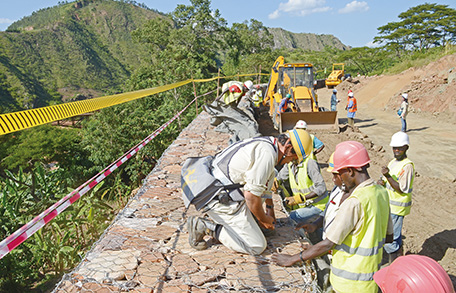Japan's Official Development Assistance White Paper 2013
Chapter 3 Hand in Hand with a More Dynamic Africa: TICAD V and Japan’s Initiatives

A Japanese engineer working and giving guidance at the Rusumo International Bridge that connects Tanzania and Rwanda (Photo: Takeshi Kuno / JICA)
Section 1 African Development: Current Status and Challenges
Suffering from poverty and low growth until the 1990s, Sub-Saharan Africa (Note 1) has achieved remarkable economic growth since the beginning of this century. Its average rate of real GDP growth in the last ten years (2002-2011) was 5.8%, significantly exceeding the world average of 3.8%. As a region, Sub-Saharan Africa had the second highest growth rate after East Asia (8.8%). Further still, Africa has more than tripled its nominal GDP (approximately $1.83 trillion) and as much as quadrupled its trade volume (approximately $997 billion) over the previous decade.
The driving forces behind the strong African economy are a stable political and security situation, abundant natural resources, and a high population growth rate. Since the beginning of this century, Africa has overcome the period of conflict and instability, and many countries have achieved peace and stability. Sub-Saharan Africa is blessed with energy resources such as crude oil and natural gas, and mineral resources which are important for Japan, such as chrome, cobalt, manganese, and vanadium. In recent years, Africa has witnessed the new development of and increased production at mines and oil and gas fields. Spiraling resource prices as a result of a sharp rise in demand in emerging countries, including China, as well as the effects of monetary easing on a worldwide level support the high growth of the African economy, including contributing to improving the current account balance of the whole of Africa.
The continued increase in Africa’s population is another key factor of growth. The average population growth rate in Africa of 2.3% is the highest among the six continents. Urbanization has also progressed rapidly, with Africa already said to have over 40 cities with populations of more than one million inhabitants. Africa’s GNI per capita in 2011 was $1,570, on par with India with a population of comparable size. Like India, Africa has considerable potential to become a vast consumer market in the future. To give the mobile phone market for example, the number of mobile connections in Africa rose to 620 million as of 2011. Africa is the second largest mobile market in the world after Asia, and further increases in its mobile connections are expected. Moreover, the Southern African Development Community SADC), East African Community (EAC), and Common Market for Eastern and Southern Africa (COMESA) are working to expand and facilitate regional trade in the area.
The strong performance of the African economy has transformed external financial flows to Africa. Although ODA used to account for the majority of financial flows to Africa, direct investment to Africa (equal to approximately $40 billion) exceeded the total amount of ODA (according to OECD, approximately $39.5 billion) in 2007. Over the past decade, the balance of direct investment to Africa nearly quadrupled (according to UNCTAD, from approximately $150 billion to approximately $569.6 billion). Growth stemming from increases in trade and consumption has brought in further direct investment, and the world’s eyes are on Africa as a business partner. The West and emerging countries have been paying attention to the potential of Africa. China, India, the Republic of Korea, and the European Union (EU) have respectively launched their own development fora with Africa and are taking steps to strengthen their relationships with Africa.
Stable economic growth has had positive impacts on the efforts to achieve the MDGs (See this page) in Sub-Saharan Africa. Progress has been observed in such areas as enrollment in primary education, gender disparity in primary education enrollment, HIV/AIDS, and tuberculosis and malaria infection. On the other hand, a host of unsolved development challenges remain in Africa. The MDGs aim to achieve eight goals by 2015, including the eradication of extreme poverty and hunger and the reduction of child mortality. Nevertheless, Africa has a long way to go before achieving such goals as poverty reduction and maternal and child health. Over 40% of the Sub-Saharan African population are still forced to live below the poverty line, and it can hardly be said that the improvements in the access of the poor to health services and to safe water and sanitation facilities have been sufficient. In addition, with the population growing at an average 2 to 3% per year, concerns pervade that future increases in young people who reach working age will heighten pressure to create jobs more than ever before.

A drill ship conducting productivity tests at a gas field already discovered off the coast of Mozambique (a ship equipped with gas field exploration and drilling facility) (Photo: Anadarko Petroleum Corporation)
Note 1: The area of the continent of Africa that lies south of the Sahara Desert
